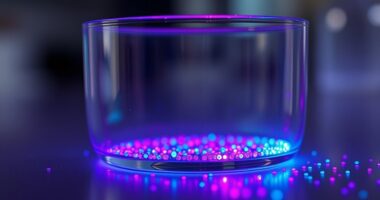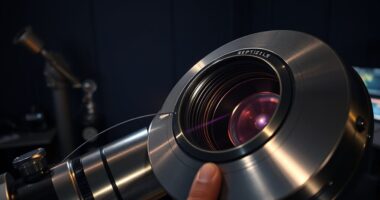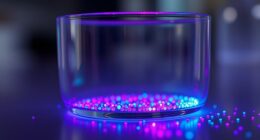UV-C sterilization offers a safe, chemical-free way to disinfect your water quickly and effectively. It works by using ultraviolet light to penetrate microorganism cell walls, disrupting DNA and rendering bacteria and viruses harmless. This method guarantees your water remains natural in taste and mineral content while providing instant, reliable purification. It’s practical for household or industrial use, even in remote areas. Want to discover how UV-C technology can keep your water safe and clean?
Key Takeaways
- UV-C light disrupts microorganism DNA, effectively neutralizing bacteria and viruses in water without chemicals.
- It provides rapid, instant sterilization as water flows through the UV chamber, ensuring quick disinfection.
- UV-C water treatment is environmentally friendly, producing no harmful byproducts or chemical residues.
- Modern units are compact, user-friendly, and require minimal maintenance, suitable for both household and industrial use.
- Technological advancements, like AI monitoring, enhance system safety, efficiency, and consistent water disinfection.

Have you ever wondered how UV-C sterilization effectively kills germs and viruses? The answer lies in the power of UV technology, which has revolutionized water purification processes. UV-C light, a specific wavelength of ultraviolet radiation, penetrates the cell walls of microorganisms, disrupting their DNA and rendering them harmless. This method offers a chemical-free, environmentally friendly way to disinfect water, making it safer to drink and use. Unlike traditional water treatment options that rely on chemicals or filtration, UV technology provides rapid, effective sterilization without introducing harmful residues.
When you use UV-C sterilization for water purification, you benefit from a process that is both efficient and straightforward. The water flows through a chamber where it’s exposed to UV-C light, which neutralizes bacteria, viruses, and other pathogens instantly. This approach is especially valuable in areas where chemical treatment might be impractical or undesirable. Because UV light targets microorganisms directly, it doesn’t alter the water’s taste or mineral content, preserving its natural qualities. Plus, UV sterilization is safe for the environment since it doesn’t produce chemical byproducts or pollutants.
One of the key advantages of UV technology in water purification is its speed. Traditional methods, such as boiling or chemical disinfection, can take time and require ongoing effort or resources. With UV sterilization, you get instant results—water is disinfected as it passes through the UV chamber, making it ideal for both household and industrial applications. It’s also a reliable method against a broad spectrum of pathogens, including bacteria like E. coli and viruses like norovirus, which are often resistant to other forms of treatment.
Moreover, UV-C sterilization systems are becoming more accessible and user-friendly. Modern units are compact, easy to operate, and require minimal maintenance. You simply need to replace the UV bulbs periodically to ensure consistent performance. This simplicity makes UV technology a practical choice for remote locations, emergency situations, or everyday home use. It’s a safe, chemical-free solution that protects you and your family from waterborne illnesses without the risks associated with chemical disinfection methods.
Additionally, advancements in AI-powered monitoring are improving the efficiency and safety of UV sterilization systems, ensuring optimal performance and early detection of equipment issues.
Frequently Asked Questions
How Does UV-C Sterilization Compare to Traditional Chemical Disinfectants?
You’ll find UV-C sterilization more effective in quickly neutralizing bacteria and viruses compared to traditional chemical disinfectants. It also has a lower environmental impact since it doesn’t produce harmful residues or chemicals. While chemical disinfectants may require longer contact times and can leave residues, UV-C provides a chemical-free, efficient, and eco-friendly solution, making it a safer choice for water disinfection without compromising chemical effectiveness.
Can UV-C Sterilization Be Used on All Types of Water Sources?
Think of UV-C sterilization as a versatile hero, but even heroes have limits. You can’t use UV-C on all water sources due to variability in water quality and potential UV-C limitations. Turbid or contaminated water might shield microbes, reducing effectiveness. So, while UV-C works well for clear, treated water, it might not be suitable for all sources without pre-treatment. Always consider water source variability before relying solely on UV-C.
What Maintenance Is Required for UV-C Sterilization Equipment?
You need to perform regular UV maintenance to keep your sterilization system effective. This includes cleaning the UV lamps and quartz sleeves to prevent buildup, replacing lamps as recommended, and inspecting for any damage. Additionally, you should conduct system calibration periodically to guarantee maximum UV output. Proper maintenance guarantees your UV‑C sterilization system continues to disinfect water efficiently and safely, protecting your water supply from contamination.
Are There Any Safety Precautions for Using UV-C Devices at Home?
Imagine UV‑C devices as tiny guardians protecting your home’s health. When handling them, always wear protective gear and avoid direct eye or skin exposure—think of it as shielding yourself from a fierce but invisible warrior. Keep devices out of children’s reach, ensure proper household safety, and follow manufacturer instructions carefully. By respecting these safety precautions, you guarantee safe device handling and maintain a secure environment for everyone at home.
How Long Does UV-C Sterilization Take to Effectively Disinfect Water?
The sterilization duration for UV-C water disinfection typically takes about 60 seconds to 3 minutes, depending on your device’s power and water quality. You should guarantee the water is exposed evenly to UV-C light for effective sterilization. Keep in mind that clearer water requires less time, whereas water with impurities may need longer exposure. Always follow your device manufacturer’s guidelines for ideal results.
Conclusion
By choosing UV-C sterilization, you harness a powerful shield against harmful microorganisms, turning your water into a fortress of safety. It’s like wielding a invisible sword that swiftly neutralizes germs without chemicals or fuss. Embrace this innovative technology, and you’ll enjoy peace of mind knowing your water is as pure as a mountain spring. With UV-C, you’re not just disinfecting—you’re shining a spotlight on safety, making clean water easier and safer for you and your loved ones.









